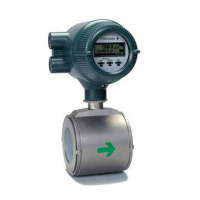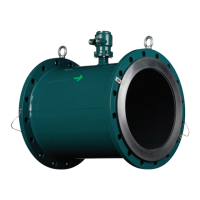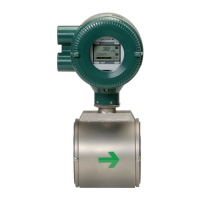4. Installation of Flameproof
Apparatus
(1) Installation Area
Flameproof apparatus may be installed, in accordance
with applicable gases, in a hazardous area in Zone 1 or 2,
wherethespeciedgasesarepresent.Thoseapparatus
shall not be installed in a hazardous area in Zone 0.
Note: Hazardousareasareclassiedinzonesbasedupon
the frequency of the appearance and the duration of an
explosive gas atmosphere as follows:
Zone 0: An area in which an explosive gas atmosphere
is present continuously or is present for long
periods.
Zone 1: An area in which an explosive gas atmosphere is
likely to occur in normal operation.
Zone 2: An area in which an explosive gas atmosphere
is not likely to occur in normal operation and if it
does occur it will exist for a short period only.
(2) Environmental Conditions
The standard environmental condition for the installation
ofameproofapparatusislimitedtoanambient
temperature range from –20°C to +40°C (for products
certiedunderTechnicalCriteria).However,someeld-
mountedinstrumentsmaybecertiedatanambient
temperature up to +60°C as indicated on the instrument
nameplates.Iftheameproofapparatusareexposed
to direct sunshine or radiant heat from plant facilities,
appropriate thermal protection measures shall be taken.
5. External Wiring for Flameproof
Apparatus
Flameproofapparatusrequirecablewiringorameproof
metal conduits for their electrical connections. For
cable wiring, cable glands (cable entry devices for
ameprooftype)towiringconnectionsshallbeattached.
Formetalconduits,attachsealingttingsascloseto
wiring connections as possible and completely seal the
apparatus. All non-live metal parts such as the enclosure
shallbesecurelygrounded.Fordetails,seethe“USER’S
GUIDELINES for Electrical Installations for Explosive Gas
AtmospheresinGeneralIndustry,”publishedin1994.
(1) Cable Wiring
• For cable wiring, cable glands (cable entry devices
forameprooftype)speciedorsuppliedwiththe
apparatus shall be directly attached to the wiring
connections to complete sealing of the apparatus.
• Screws that connect cable glands to the apparatus
arethoseforG-typeparallelpipethreads(JISB0202)
with no sealing property. To protect the apparatus
from corrosive gases or moisture, apply nonhardening
sealant such as liquid gaskets to those threads for
waterproong.
• Speciccablesshallbeusedasrecommendedby
the“USER’SGUIDELINESforElectricalInstallations
forExplosiveGasAtmospheresinGeneralIndustry,”
published in 1994.
• In necessary, appropriate protective pipes (conduit
orexiblepipes),ductsortraysshallbeusedfor
preventing the cable run (outside the cable glands)
from damage.
• To prevent explosive atmosphere from being
propagated form Zone 1 or 2 hazardous location
to any different location or non-hazardous location
through the protective pipe or duct, apply sealing
of the protective pipes in the vicinity of individual
boundaries,orlltheductswithsandappropriately.
• When branch connections of cables, or cable
connections with insulated cables inside the conduit
pipesaremade,aameprooforincreased-safety
connectionboxshallbeused.Inthiscase,ameproof
or increased-safety cable glands meeting the type of
connection box must be used for cable connections to
the box.
(2) Flameproof Metal Conduit Wiring
• Fortheameproofmetalconduitwiringorinsulated
wires shall be used as recommended by the USER’S
GUIDELINES for Electrical Installations for Explosive
Gas Atmospheres in General Industry, published in
1994.
• For conduit pipes, heavy-gauge steel conduits
conformingtoJISC8305Standardshallbeused.
• Flameproofsealingttingsshallbeusedinthevicinity
ofthewiringconnections,andthosettingsshallbe
lledwithsealingcompoundstocompletesealing
of the apparatus. In addition, to prevent explosive
gases,moisture,oramecausedbyexplosionform
being propagated through the conduit, always provide
sealingttingstocompletesealingoftheconduitin
the following locations:
(a) In the boundaries between the hazardous and
non-hazardous locations.
(b) In the boundaries where there is a different
classicationofhazardouslocation.
• For the connections of the apparatus with a conduit
pipe or its associated accessories, G-type parallel
pipethreads(JISB0202)shallbeusedtoprovide
aminimumofve-threadengagementtocomplete
tightness. In addition, since these parallel threads
do not have sealing property, nonhardening sealant
such as liquid gaskets shall thus be applied to those
threads for ensuring waterproofness.
• Ifmetalconduitsneedexibility,useameproof
exiblettings.

